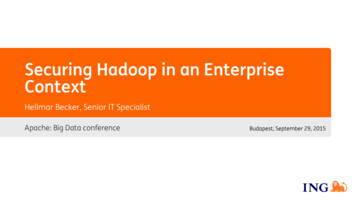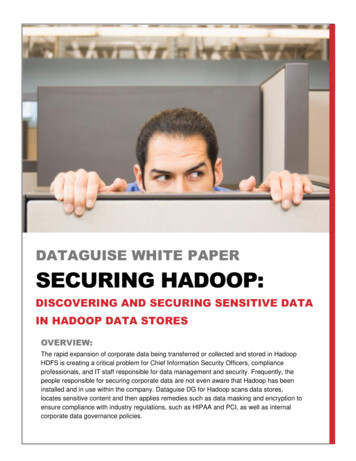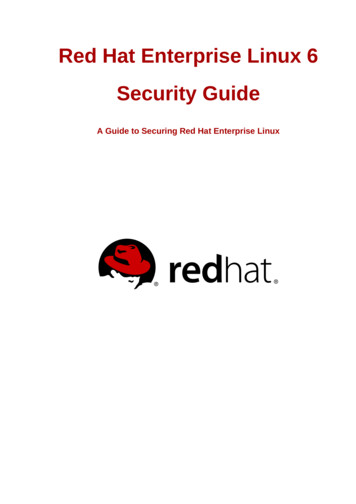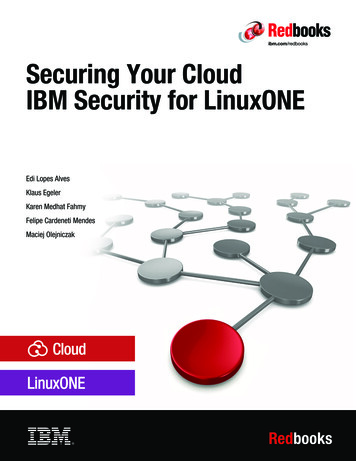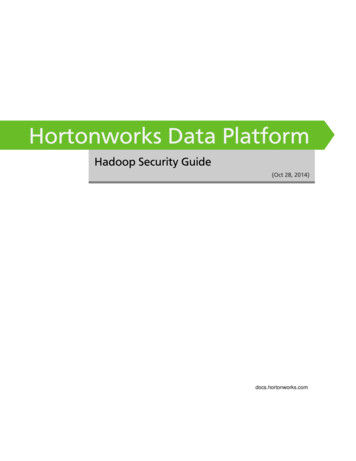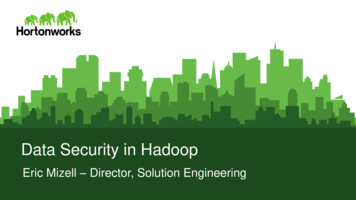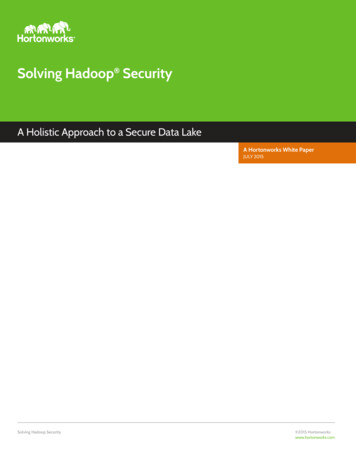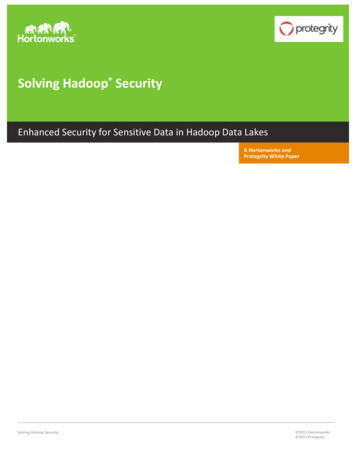
Transcription
Securing Hadoop: SecurityRecommendations forHadoop EnvironmentsVersion 2.0Updated: March 21, 2016Securosis, L.L.C.515 E. Carefree Highway Suite #766 Phoenix, AZ 85085info@securosis.com www.securosis.comT 602-412-3051
This report licensed by Hortonworks.Hortonworks is the leader in emerging Open Enterprise Hadoop and develops, distributes andsupports the only 100% open source Apache Hadoop data platform. Our team comprises thelargest contingent of builders and architects within the Hadoop ecosystem who represent and leadthe broader enterprise requirements within these communities. The Hortonworks Data Platformprovides an open platform that deeply integrates with existing IT investments and upon whichenterprises can build and deploy Hadoop-based applications.Hortonworks has deep relationships with the key strategic data center partners that enable ourcustomers to unlock the broadest opportunities from Hadoop.For more information, visit www.hortonworks.comThis report licensed by Vormetric.Vormetric’s comprehensive high-performance data security platform helps companies moveconfidently and quickly. Our seamless and scalable platform is the most effective way to protect datawherever it resides—any file, database and application in any server environment. Advancedtransparent encryption, powerful access controls and centralized key management let organizationsencrypt everything efficiently, with minimal disruption. Regardless of content, database or application—whether physical, virtual or in the cloud—Vormetric Data Security enables confidence, speed andtrust by encrypting the data that builds business.Please visit: www.vormetric.com and find us on Twitter @Vormetric.Securing Hadoop"2
Author’s NoteThe content in this report was developed independently of any licensees. It is based on materialoriginally posted on the Securosis blog, but has been enhanced, reviewed, and professionally edited.Special thanks to Chris Pepper for editing and content support.CopyrightThis report is licensed under Creative Commons Attribution-Noncommercial-No Derivative c-nd/3.0/us/Securing Hadoop"3
Table of ContentsExecutive Summary5Introduction7Architecture and Composition9Systemic Security12Operational Security14Architecting for Security17Technical Recommendations25About the Analyst29About Securosis30Securing Hadoop"4
Executive SummaryThere is absolutely no question that Hadoop is a fundamentally disruptive technology. Newadvancements — in scalability, performance, and data processing capabilities — have been hittingus every few months over the last 4 years. This open source ecosystem is the very definition ofinnovation. Big data has transformed data analytics — providing scale, performance, and flexibilitythat were simply not possible a few years ago, at a cost that was equally unimaginable. But asHadoop becomes the new normal IT teams, developers, and security practitioners are playingcatch-up to understand Hadoop security.This research paper lays out a series of recommended security controls for Hadoop, along with therationale for each. Our analysis is based upon conversations with dozens of data scientists,developers, IT staff, project managers, and security folks from companies of all sizes; as well as ourdecades of security experience. These recommendations reflect threats and regulatory requirementsIT must address, along with a survey of available technologies which practitioners are successfullydeploying to meet these challenges.Summary of RecommendationsIn this paper we focus on how to build security into Hadoop to protect clusters, applications, anddata under management. Our principal concerns include how nodes and client applications arevetted before joining the cluster, how data at rest is protected from unwanted inspection, assuringthe privacy of network communications, key management, and how various functional modules aremanaged. The security of the web applications that use big data clusters is equally important, butthose challenges also exist outside big data clusters, so they are outside our scope for this paper.Our base recommendations are as follows: Use Kerberos — typically bundled with Hadoop — to validate nodes and clientapplications before admission to the cluster, and to support other identity functions. Use file/OS layer encryption — to protect data at rest, ensure administrators andapplications cannot directly access files, and prevent information leakage. Use key/certificate management — you cannot simply store keys and certificateson disk and expect them to be safe. Use a central key management server to protect encryptionkeys and manage different keys for different files.Securing Hadoop"5
Use Apache Ranger to track module configuration and to set usage policies for finegrained control over data access. Validate nodes prior to deployment — through virtualization technologies, cloudprovider facilities, and scripted deployments based on products such as Chef and Puppet. Use SSL or TLS network security — to authenticate and ensure privacy ofcommunications between nodes, name servers, and applications. Log transactions, anomalies, and administrative activity — through logging toolsthat leverage the big data cluster itself — to validate usage and provide forensic system logs.Securing Hadoop"6
IntroductionHadoop is Enterprise Software.There, we said it. In the last few years Hadoop has matured from a simple distributed datamanagement system for running MapReduce queries, into a full-blown application framework forprocessing massive amounts of data using just about any method you can conceive. We are longpast wondering whether Hadoop is a viable technology, but still coming to terms with its broadimpact on data processing in general. Treating Hadoop as just another open source distribution oranalytics tool is a mistake. Our research shows Hadoop is affecting the course of most newapplication development within enterprises.Having demonstrated its value, Hadoop is now being embraced both by enterprises and the midmarket, running just about every type of data processing and analytics you can imagine. Over 70%of large firms we spoke with are running Hadoop somewhere within their organizations. Apercentage are running Mongo, Cassandra or Riak in parallel, but Hadoop is unquestionably “theface of big data”.But many IT personnel still regard open source with suspicion, and Hadoop as an interloper — alarge part of the rogue IT problem. This may surprise some readers, but most big data projects groworganically as ‘skunkworks’ development efforts— often outside IT governance — so IT folks stillstruggle to accept Hadoop as “enterprise ready”. Make no mistake — “proof of concept” projectsjust a couple years ago have evolved into business-critical enterprise applications. Hadoop’s value iswidely accepted, and these systems are here to stay, but now they must adhere to corporatesecurity and data governance frameworks.The Enterprise Adoption CurveGetting Hadoop secure is a basic hurdle most IT and security teams now face. They are tasked withgetting a handle on Hadoop security — but more importantly applying existing data governance andcompliance controls to the cluster. Like all too many security projects, these initiatives to secureexisting installations are coming in late. We spoke with many people responsible for Hadoopsecurity, but who are not fully versant in how Hadoop works or how to manage it — much less howto secure it. The most common questions we get from customers are simple ones like “How can Isecure Hadoop?” and “How can I map existing data governance policies to NoSQL platforms?”It has been about four years since we published our research paper on Securing Big Data — one ofthe more popular papers we’ve ever written — but the number of questions has increased over time.And no wonder — adoption has been much faster than we expected. We see hundreds of new bigSecuring Hadoop"7
data projects popping up. At the time we wrotethe original paper, security for Hadoop clusterswas something of a barren wasteland. Hadoopdid not include basic controls for data protection;and most third-party tools could not scale alongwith NoSQL and so were little use to developers.And things did not look likely to get better anytime soon as leaders of NoSQL firms directedresources to improving performance andscalability rather than security. Early versions ofHadoop has (mostly)reached security parity withthe relational platforms ofold, and that’s saying a lotgiven their 20-year headstart.Hadoop we evaluated did not even require anadministrative password!The good news is that we were wrong about the pace of security innovation. Hadoop’s functionalmaturity improvements over the last few years have been matched by much better security andgovernance capabilities. As large enterprises started to embrace this technology platform, theypushed the vendors of enterprise Hadoop distributions, and made security and compliance nonnegotiable components of their minimum requirements. Between the open source community andthe commercial vendors, they delivered the majority of the missing pieces. Now security controls arenot only available, but for most requirements more than one option.There remain gaps in monitoring and assessment capabilities, but Hadoop has (mostly) reachedsecurity parity with the relational platforms of old, and that’s saying a lot given their 20-year headstart. Because of this rapid advancement, a fresh review of Hadoop security is in order. The reminderof this paper will provide a brief overview of Hadoop’s architecture, and highlight security challengesfor those not yet fully versed in how clusters are built. We will then offer a fairly technical set ofstrategic and tactical responses to address these challenges. Our goal is to help those tasked withHadoop security address risks to the cluster, as well as build a governance framework to supportoperational requirements.Securing Hadoop"8
Architecture and CompositionOur goal for this section is to succinctly outline what Hadoop clusters look like, how they areassembled, and how they are used. This facilitate understanding of the security challenges, alongwith which sort of protections can secure them. Developers and data scientists continue to stretchsystem performance and scalability, using customized combinations of open source and commercialproducts, so there is really no such thing as a ‘standard’ Hadoop deployment. For example, someplace all of their data into a single Hadoop 'Data Lake' supporting dozens of applications, whileothers leverage multiple clusters, each tuned for the specific business requirement.Some of you reading this are already familiar with the architecture and component stack of aHadoop cluster. You may be asking, “Why are we reviewing these basics?” To understand threatsand appropriate responses, one must first understand how all the pieces work together. Noteveryone reading this guide is familiar with the Hadoop framework, and while it’s not essential forreaders to understand what each component does, it is important to understand each componentinterface as an attack target. Each component offers attacker a specific set of potential exploits,while defenders have a corresponding set of options for attack detection and prevention.Understanding architecture and cluster composition is the first step to putting together your securitystrategy.The following is a simplified view of Apache Hadoop’s underlying MapReduce system:Securing Hadoop"9
Architecture and Data FlowHadoop has been wildly successful because it scales extraordinarily well, can be configured tohandle a wide variety of use cases, and is incredibly inexpensive compared to older — mostlyproprietary — data warehouse alternatives. Which is all another way of saying Hadoop is cheap,fast, and flexible. To see why and how it scales, take a look at a Hadoop cluster architecture,illustrated in the above diagram.This architecture promotes scaling and performance. It supports parallel processing, with additionalnodes providing ‘horizontal’ scalability. This architecture is also inherently multi-tenant, supportingmultiple client applications across one or more file groups. There are several things to note here froma security perspective. There are many moving parts — each node communicates with its peers toensure that data is properly replicated, nodes are on-line and functional, storage is optimized, andapplication requests are being processed. Each line in the diagram is a trust relationship utilizing acommunication protocol.The Hadoop FrameworkTo appreciate Hadoop’s flexibility you need to understand that clusters can be fully customized. Forthose of you new to Hadoop it may help to think of the Hadoop framework as a ‘stack’, much like aLAMP stack, only on steroids. With a jetpack and night-vision googles. The extent to which you canmix and add components is incredible. While HBase is often used on top of HDFS, you mightchoose a different style of search, such as Solr. You can use Sqoop to provide relational dataaccess, or leverage Pig for high level MapReduce functions. You can select different SQL querySecuring Hadoop"10
engines — with Spark, Drill, Impala, and Hive all accommodating SQL queries. This modularity offersgreat flexibility to assemble and tailor clusters to perform exactly as desired.It’s not just that Hadoop can handle data processing in different ways, or that you can adjust itsperformance characteristics, alter scheduling, or add input data parsing. A Hadoop cluster can betailored to fit the exact needs of your business or applications. Need something different? Add a newmodule. You can design a cluster to satisfy your usability, scalability, and performance goals. Youcan tailor it to specific types of data, or add modules to facilitate analysis of certain data sets.But flexibility brings complexity: A dynamic framewo
21.03.2016 · Getting Hadoop secure is a basic hurdle most IT and security teams now face. They are tasked with getting a handle on Hadoop security — but more importantly applying existing data governance and compliance controls to the cluster. Like all too many security projects, these initiatives to secure existing installations are coming in late. We spoke with many people responsible for Hadoop
